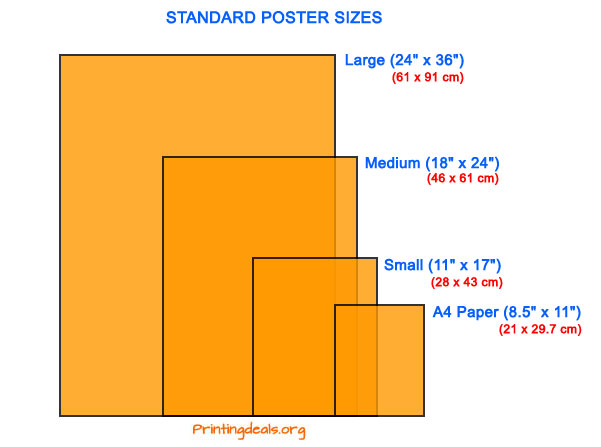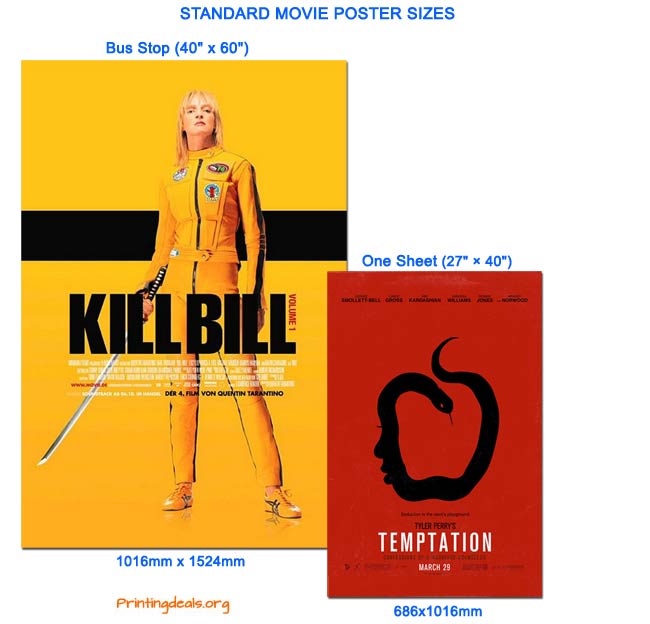While there is no official standard size for posters, over the decades many printing and advertising companies have been using the same consistent sizes for poster printing.
This resource discusses the dimensions and rules that are commonly used for printing posters worldwide. Using the dimensions in this guide will assure your poster printing project will turn out to be a success - no matter what printing company you choose.

Also called Ledger, Tabloid or ANSI B size. This is the smallest standard poster size, they are mostly used for flyers, street lights, bulletin boards, and generally putting up on businesses without taking up too much room and offending. These also work great with a minimalist approach to text. Big letters big message. Size in Millimetres is 279 x 432mm.
Also called Architectural C size - A little more information can be displayed on this standard poster size. I would still recommend some minimalism and little text. These posters are mainly seen as small adverts on university residence floors, doctor's offices, construction walkways and bulletin boards. Size in Millimetres is 457 × 610mm.
Also called Architectural D Size - This is the most common standard size for posters. These posters are used for most applications including outside of events, trade shows, and malls. Also widely used for small movie posters delivered to fans and posters for decoration like in University residences and outside a pub or club. With these types of posters you will be grabbing attention with a large message and you can include further details in small writing so after the message is received people can choose whether to come closer and learn more. Size in Millimetres is 609.6 mm x 914.4 mm.
Note: If you are designing a poster you cannot go wrong by using the dimensions that we described above, they are used by printing companies worldwide. Don't be afraid to work with different dimensions though: Posters are printed on rolls of paper (not on sheets) and can therefore be cut in any other dimension. If you want create a poster larger than 24 x36 Inch be sure to contact your printer first, and confirm that he is able to print your desired size.There are 2 different dimensions for movie posters that the film industry has standardized. Both are typically in portrait format:
The "One-Sheet" size is used in the official advertising for films.
Both are typically printed on paper stock and usually rolled for aesthetic reasons.
Be aware that the mentioned dimensions for film posters are approximate, and do not have to be exactly in the sizes mentioned above.

Note: Film posters sold in retailing are in poster size, which is 24 x 36 inches.
Common landscape (horizontal oriented) format movie Posters also called HALF-SHEET measure 22" x 28", and are generally printed on thicker stock paper.
For further in-depth information about movie poster sizes visit Cinemasterpieces and Wikipedia.
Choosing the right paper to print your posters is essential. The first thing to note is: Always use Acid free paper for poster printing. You do not want your printed poster to turn yellow after a while, therefore the papers you use for printing should be acid free.
The best stock to use for your poster depends on many factors, that are not defined by hard rules.
These factors include:
As a rule you want to make sure to use stock that is heavier (thicker) then default printer papers.
Not only does this add durability to your poster, it will age much better then standard paper, and your poster is much easier to flatten.
We recommend to choose paper weight of at least 60lbs (90 g/m2) or above for your poster project. This really is the minimum weight you should choose for (bulk) production.
If your budget allows it, preferably choose heavier papers like (80 lbs - 120 g/m2 or 90 lbs - 163 g/m2). This will give your poster a more luxurious feel and will add longevity to your poster.
When creating your own poster make sure to create your document in CMYK mode in 300DPI and set a healthy amount of bleed around the edges so that essential pieces of the poster are not cut off after the printing. For more information read our printing guide to avoid common printing mistakes.
» Free downloadable high-res Vintage posters for printing.
» Reviews of the best poster printing services.
perfect experience with this company: user-friendly design software, reasonable prices and professional product. Got a coffee mug printed: it exceeded my expectations. Will use again!
 Rating: 5 / 5
Rating: 5 / 5
Inkgarden offers the most flexibility with their design tools. You can actually save your design to complete it later, and their tools allow you to exactly position where the design is located on the product that you create. Adding text is easy, you can use multiple designs, choose if you want to use single or double sided, etc, etc.
Product quality was satisfying, and customer service was helpful.
I will definately use them again.
 Rating: 5 / 5
Rating: 5 / 5
I use Overnight Prints to get my business out there. Bookmarks, calendars, flyers and business cards are just some of the items I ordered in the last year. I came to this site looking for a coupon to order a iPhone case, but looks like they are not available yet.When will they be available?
Anyway, if you want great quality at great prices, give them a try!
 Rating: 5 / 5
Rating: 5 / 5
I received my business card order this morning, quite some days sooner than my order tracker emails said they would arrive and honestly i do not remember ever being this impressed by a product i ordered online.
Well done Moo... The whole experience with you was great: how everything was packaged, the quality, the service, the site. Everything. Super super super.
 Rating: 5 / 5
Rating: 5 / 5
Pretty good price / quality ratio.
They offer you a full range of styles and colors. They will also notify you in case your text or image are inappropriate.
Shipping was terribly slow. They need to work on that.
 Rating: 4 / 5
Rating: 4 / 5
